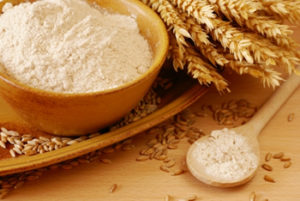Wheat Flour is a powder made from the grinding of wheat used for human consumption. More wheat flour is produced than any other flour. Wheat varieties are called “soft” or “weak” if gluten content is low, and are called “hard” or “strong” if they have high gluten content. Hard flour, or bread flour, is high in gluten, with 12% to 14% gluten content, and its dough has elastic toughness that holds its shape well once baked. Soft flour is comparatively low in gluten and thus results in a loaf with a finer, crumbly texture. Soft flour is usually divided into cake flour, which is the lowest in gluten, and pastry flour, which has slightly more gluten than cake flour.
Uses
-
For consumption.
Benefits
- Fiber ContentOne of the primary nutritional differences between whole-wheat and white flour is the food’s fiber content. Dietary fiber has a number of health benefits — it prevents constipation, lowers blood cholesterol and might help you lose weight, according to Colorado State University.
- Effect on Blood SugarAny carbohydrate-containing food — including those containing either whole-wheat and white flour — has some effect on your blood sugar. After you eat a meal, your body breaks the carbohydrates from your food into glucose, a simple sugar. This glucose then enters your bloodstream, so it can circulate throughout your body and provide fuel to your cells.
- Vitamin ContentWhole-wheat flour provides a nutritional advantage over some white flours due to its vitamin content. Whole-wheat flour contains several vitamins, including folate, riboflavin and vitamins B-1, B-3 and B-5. Some types of white flour contain lower levels of these vitamins, since the processing involved in making white flour destroys the grains’ vitamin content — for example, 1/2 cup of whole-wheat flour contains 3 milligrams of niacin, while an equivalent portion of white flour contains only 0.8 milligrams. To combat this, some food manufacturers enrich their white flour with vitamins to replace the nutrients lost during processing. As a result, whole-grain flour often contains higher levels of vitamins than unenriched white flour but roughly compares to vitamin-enriched white flour.
Cautions
n/a
Interactions
n/a
Other names
n/a
References
Source: Wikipedia, https://en.wikipedia.org/wiki/Wheat_flour
Healthyeating, http://healthyeating.sfgate.com/healthy-wholewheat-flour-vs-white-3305.html

